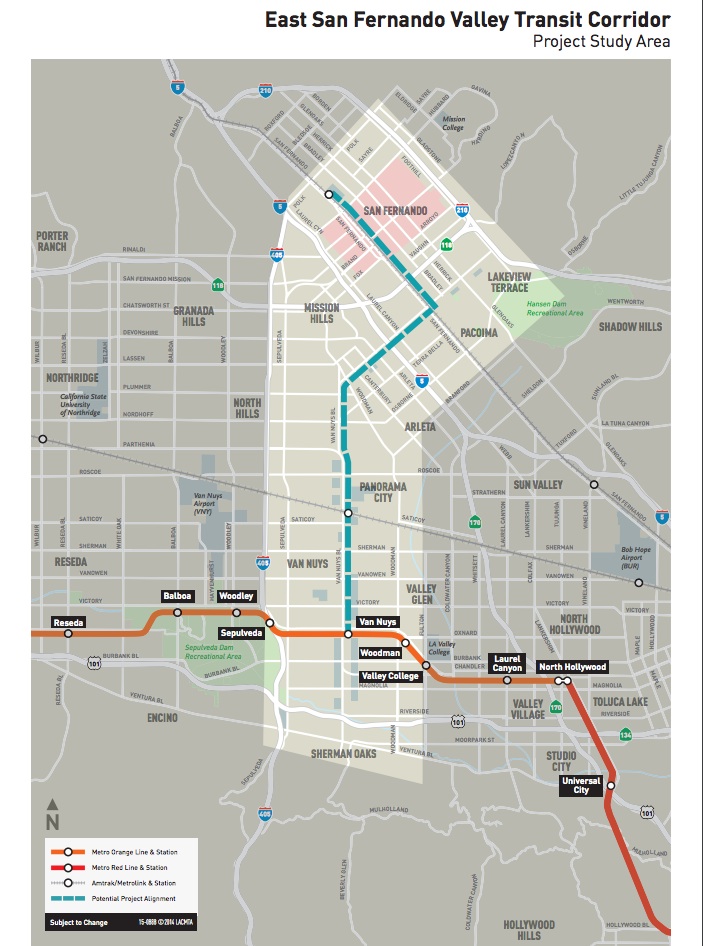Why the East San Fernando Valley Transit Corridor deserves your support
Are you tired of being stuck in traffic in the San Fernando Valley? Here's a way to be part of the solution. The Los Angeles Metropolitan Transit Authority has spent several years studying the possibility of creating a 9.2-mile line that would travel from Sylmar at the San Fernando Road Metrolink station at its northern end and then head south on Van Nuys Boulevard to the Orange Line station.
The Sierra Club has long supported mass transit projects that cut down on vehicle emissions. The club sees this proposal as a critical transit corridor, part of a fast, high-capacity line that would travel from the North Valley to Westwood, and in the future, to Los Angeles International Airport, or LAX. We welcome the eSFV Transit Corridor project as the first section of what must be planned as a single rail corridor from the north valley, including connection to Santa Clarita, and to Westwood and LAX going south. It's a light-rail plan that's compatible with the necessary speed and capacity of a much longer line.
 Why build this transit corridor next? Here are some insights on how Valley residents are using mass transit now.
Why build this transit corridor next? Here are some insights on how Valley residents are using mass transit now.
- Van Nuys Boulevard has the second highest number of transit passengers in the San Fernando Valley, second only to the 30,000 daily ridership of the Metro Orange Line.
- On weekdays, there are nearly 25,000 passengers on Metro buses operating on Van Nuys Boulevard.
- About 50% of the boulevard’s boardings occur along a 2.8-mile stretch between the Orange Line and Roscoe Boulevard.
- In that same area transit users experience the slowest bus speeds. Buses slow to about 10 mph during the evening rush hours.
This proposed 9.2-mile Van Nuys corridor is designed to help the long underserved East Valley, a low-income community that is transit dependent. Check out this map of the study area, taken from Metro’s Draft EIR/EIS.
In September, MTA staff held five public hearings near where the proposed new line could be built. At each meeting, the agency made a presentation summarizing some features of their Draft EIR/EIS. Afterward, a court reporter documented stakeholders' comments, allowing 2 minutes for each person to explain why they want one of four alternative technologies with differing numbers of stops along the route. There were also renderings showing where the different number of stops would be for all four different build alternatives the MTA is considering.
So what’s the real difference between buses, a tram, or rail?
The two bus alternatives, and the light rail train/tram alternative are all about 10 minutes slower at covering the same distance as the rail option. That is expected to take only 29 minutes to complete the north/south line from end to end. The tram alternative is projected to take 42 minutes to cover the 9.2-mile route because it is planned with 28 stations, and no grade separation. The tram alternative also has a lesser ability to increase its capacity over time than light rail. In sharp contrast, the rail alternative has only 14 stations, and its capacity, or ability to double and triple its ridership over time as ridership increases in the future, is significantly better than other alternatives. The rail option is also planned to go underground at three stations.
By the way, a tram is a low-floor light rail train, half-again or twice the length of one light rail car. The problems with Metro’s tram alternative are; (1) it is entirely above ground with many more stops, and so, would be slower, and (2) a tram has half the capacity of a three- or four-car light-rail train.
Metro staff offer the four quite specific alternatives to choose from to relieve the serious and increasing traffic congestion along Van Nuys Boulevard. Stakeholders who live, work, go to school or recreate in the east SFV now have a chance to submit their comments to their Draft EIR/EIS.
Here are some comments from San Fernando Valley residents:
“Crenshaw got a partial subway where narrow, median rail where wider. Doesn’t the Valley deserve the same?”
“I would use rail every time instead of driving in the Valley, and to get over the hill if it’s as fast and reliable as my car. I’d prefer not to have to drive on the freeway.”
If you currently travel from the Valley to the Westside and want an alternative to the horrible traffic, or if you are transit-dependent, consider the faster alternative of light rail.
The MTA says it wants to hear from us about why we would use the new line and how it will benefit us. But, given that not many people want to read the 1,000 page Draft EIR/EIS, you might want to check out the 78-page Executive Summary. For more info you can go to www.metro.net/eastsfvtransit.
To tell them your preference, and why, email: eastsfvtransit@metro.net or write to: eSFV Transit Corridor, One Gateway Plaza, M/S 99-22-3, Los Angeles, CA 90012, or call (818) 276-3233.
To learn more about the Draft EIR/EIS Report, visit www.metro.net/eastsfvtransit. Comments must be submitted by Oct. 30.
After conclusion of the public comment period, the Metro Board of Directors will be asked to select a Locally Preferred Alternative (LPA).
Want to know more? Email Jan Kidwell at jankidwell@sbcglobal.net or Darrell Clarke at darrclarke@gmail.com. They are members of the Angeles Chapter's Sierra Club Transportation Committee.



Add new comment